Abstract
(Me-Ile-4)cyclosporin (SDZ NIM 811) is a 4-substituted cyclosporin which is devoid of immunosuppressive activity but retains full capacity for binding to cyclophilin and exhibits potent anti-human immunodeficiency virus type 1 (HIV-1) activity. SDZ NIM 811 selectively inhibits HIV-1 replication in T4 lymphocyte cell lines, in a monocytic cell line, and in HeLa T4 cells. Furthermore, its antiviral activity against laboratory strains and against clinical isolates from geographically distinct regions in primary T4 lymphocytes and in primary monocytes (50% inhibitory concentration = 0.011 to 0.057 micrograms/ml) was demonstrated. SDZ NIM 811 does not inhibit proviral gene expression or virus-specific enzyme functions, either free or bound to cyclophilin. The compound does not influence CD4 expression or inhibit fusion between virus-infected and uninfected cells. SDZ NIM 811 was, however, found to block formation of infectious particles from chronically infected cells. Oral administration to mice, rats, dogs, and monkeys resulted in levels in blood considerably exceeding the drug concentration, which completely blocked virus replication in primary cells. SDZ NIM 811 caused changes of toxicity parameters in rats to a smaller degree than cyclosporine (formerly cyclosporin A). Thus, the potent and selective anti-HIV-1 activity of SDZ NIM 811 and its favorable pharmacokinetic behavior together with its lower nephrotoxicity than that of cyclosporine make this compound a promising candidate for development as an anti-HIV drug.
Full text
PDF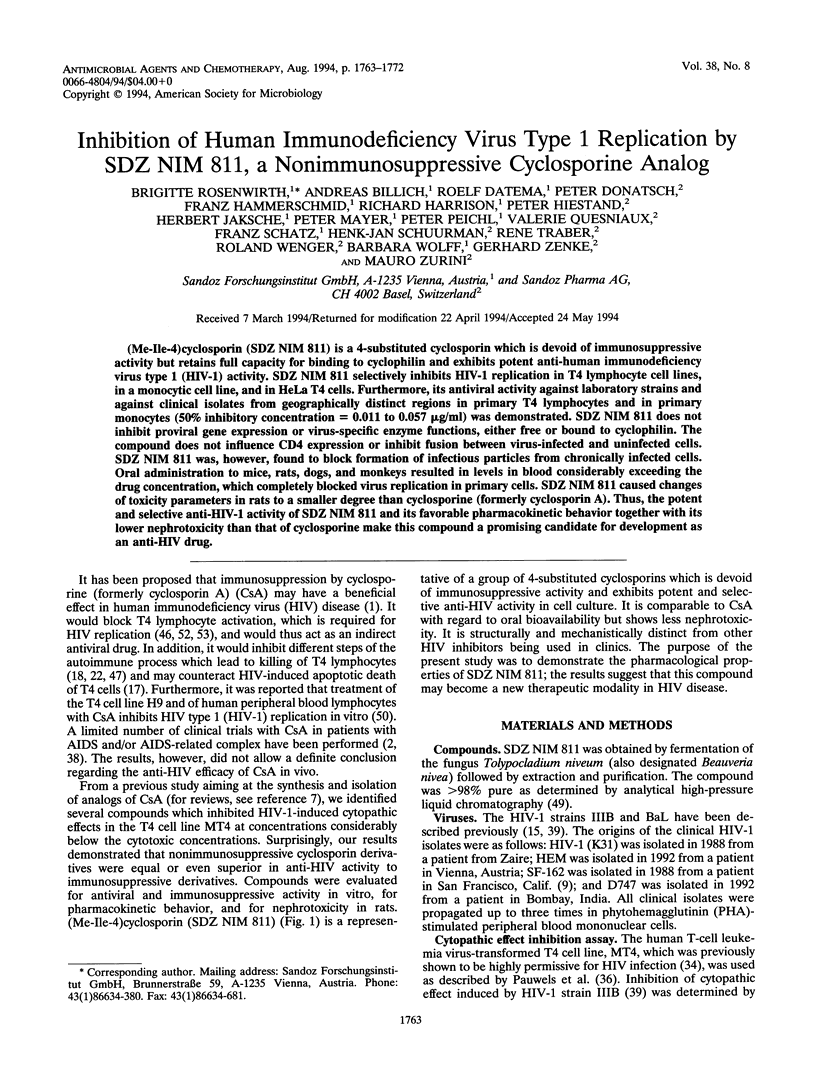
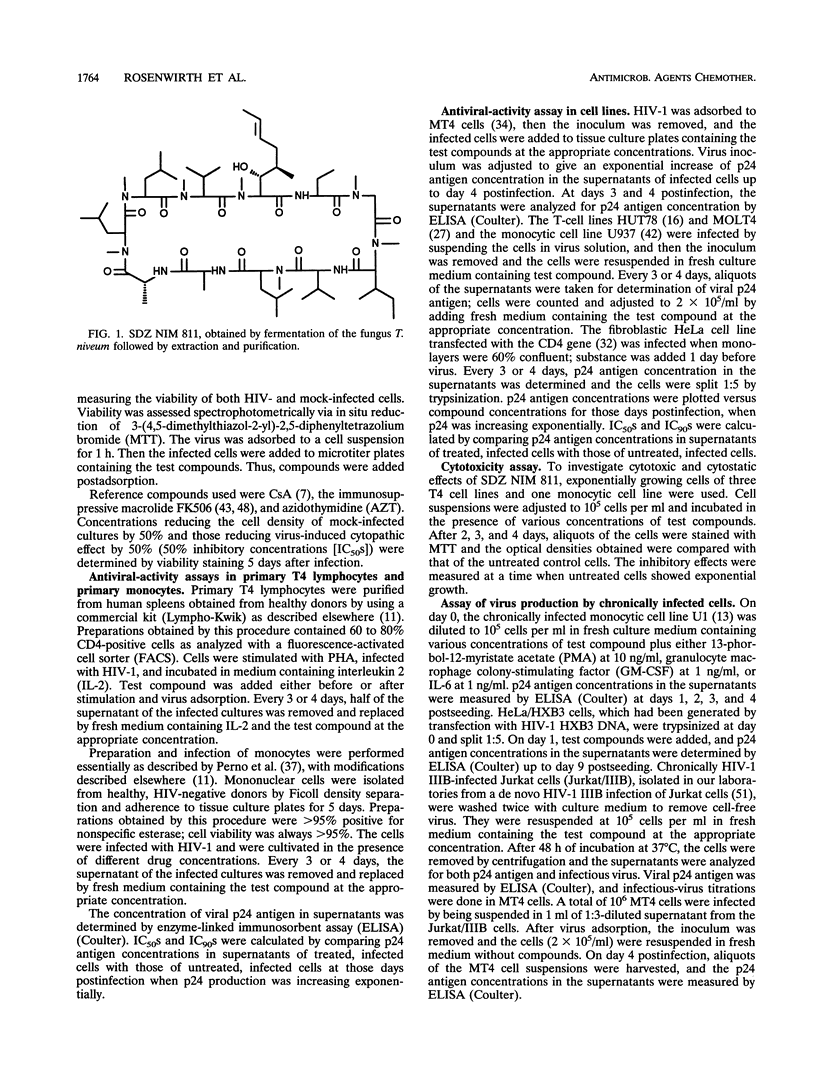

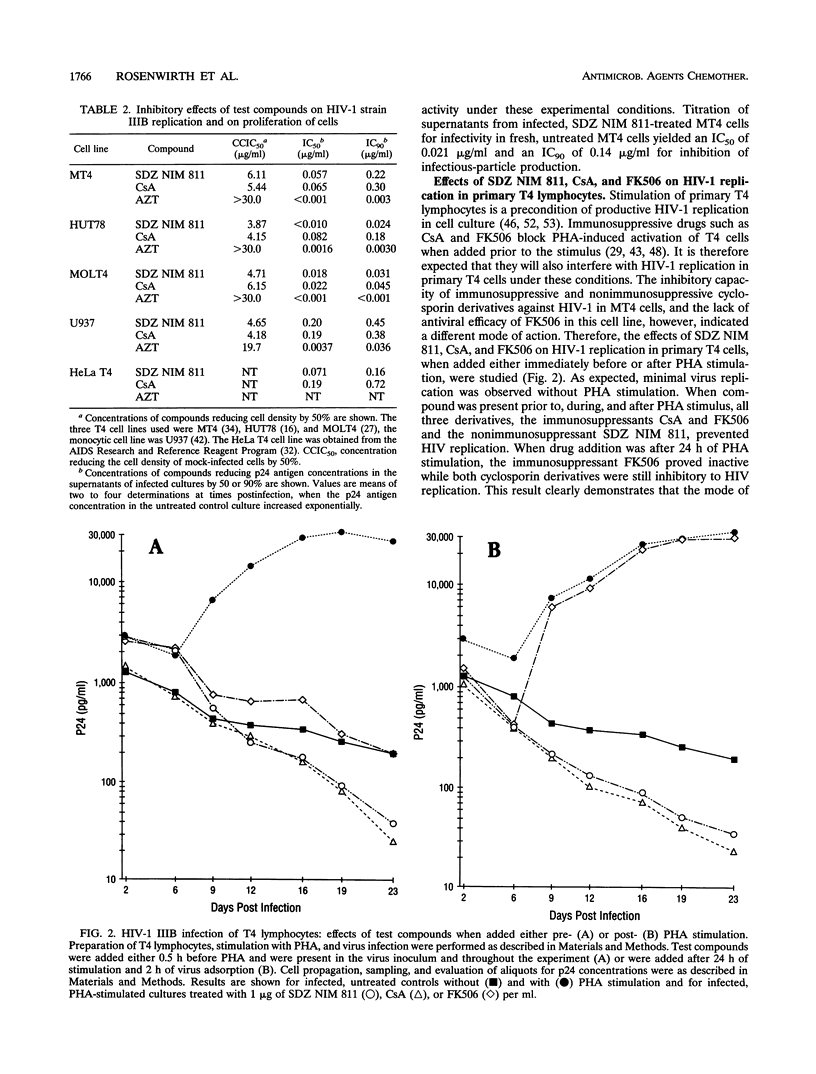




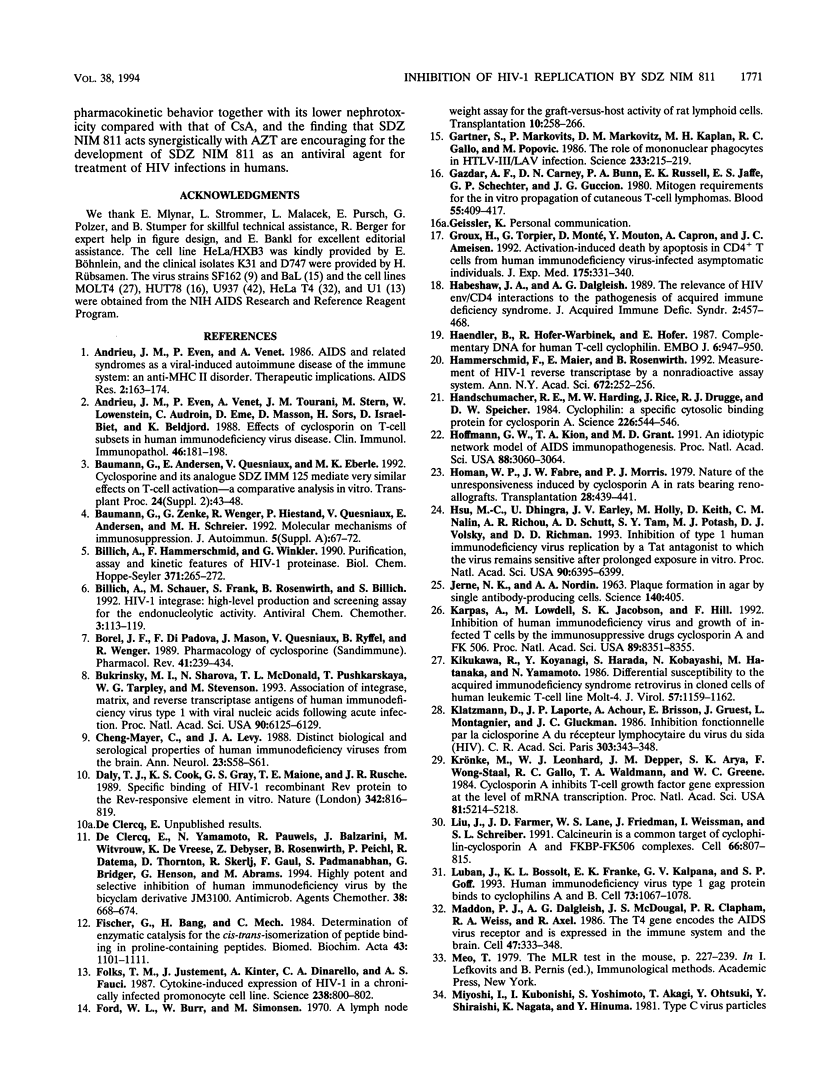
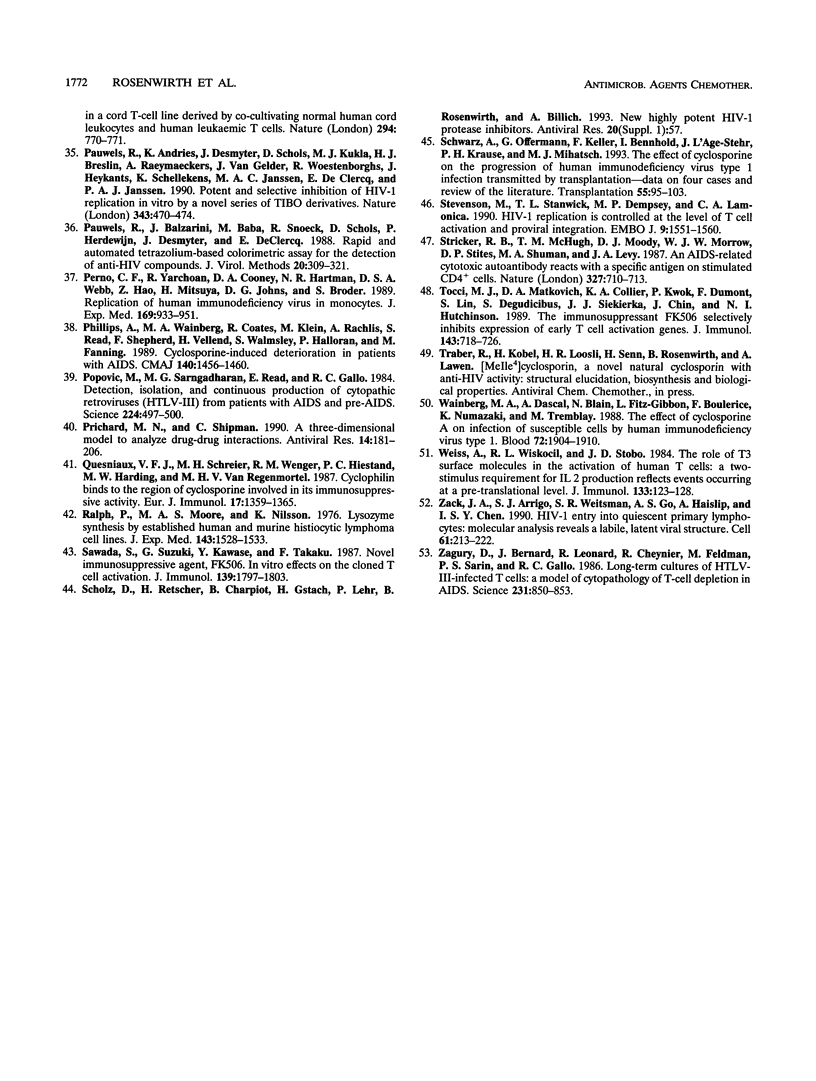
Selected References
These references are in PubMed. This may not be the complete list of references from this article.
- Andrieu J. M., Even P., Venet A. AIDS and related syndromes as a viral-induced autoimmune disease of the immune system: an anti-MHC II disorder. Therapeutic implications. AIDS Res. 1986 Summer;2(3):163–174. doi: 10.1089/aid.1.1986.2.163. [DOI] [PubMed] [Google Scholar]
- Andrieu J. M., Even P., Venet A., Tourani J. M., Stern M., Lowenstein W., Audroin C., Eme D., Masson D., Sors H. Effects of cyclosporin on T-cell subsets in human immunodeficiency virus disease. Clin Immunol Immunopathol. 1988 May;47(2):181–198. doi: 10.1016/0090-1229(88)90071-2. [DOI] [PubMed] [Google Scholar]
- Baumann G., Andersen E., Quesniaux V., Eberle M. K. Cyclosporine and its analogue SDZ IMM 125 mediate very similar effects on T-cell activation--a comparative analysis in vitro. Transplant Proc. 1992 Aug;24(4 Suppl 2):43–48. [PubMed] [Google Scholar]
- Baumann G., Zenke G., Wenger R., Hiestand P., Quesniaux V., Andersen E., Schreier M. H. Molecular mechanisms of immunosuppression. J Autoimmun. 1992 Apr;5 (Suppl A):67–72. doi: 10.1016/0896-8411(92)90021-h. [DOI] [PubMed] [Google Scholar]
- Billich A., Hammerschmid F., Winkler G. Purification, assay and kinetic features of HIV-1 proteinase. Biol Chem Hoppe Seyler. 1990 Mar;371(3):265–272. [PubMed] [Google Scholar]
- Borel J. F., Di Padova F., Mason J., Quesniaux V., Ryffel B., Wenger R. Pharmacology of cyclosporine (sandimmune). I. Introduction. Pharmacol Rev. 1990 Sep;41(3):239–242. [PubMed] [Google Scholar]
- Bukrinsky M. I., Sharova N., McDonald T. L., Pushkarskaya T., Tarpley W. G., Stevenson M. Association of integrase, matrix, and reverse transcriptase antigens of human immunodeficiency virus type 1 with viral nucleic acids following acute infection. Proc Natl Acad Sci U S A. 1993 Jul 1;90(13):6125–6129. doi: 10.1073/pnas.90.13.6125. [DOI] [PMC free article] [PubMed] [Google Scholar]
- Cheng-Mayer C., Levy J. A. Distinct biological and serological properties of human immunodeficiency viruses from the brain. Ann Neurol. 1988;23 (Suppl):S58–S61. doi: 10.1002/ana.410230716. [DOI] [PubMed] [Google Scholar]
- Daly T. J., Cook K. S., Gray G. S., Maione T. E., Rusche J. R. Specific binding of HIV-1 recombinant Rev protein to the Rev-responsive element in vitro. Nature. 1989 Dec 14;342(6251):816–819. doi: 10.1038/342816a0. [DOI] [PubMed] [Google Scholar]
- De Clercq E., Yamamoto N., Pauwels R., Balzarini J., Witvrouw M., De Vreese K., Debyser Z., Rosenwirth B., Peichl P., Datema R. Highly potent and selective inhibition of human immunodeficiency virus by the bicyclam derivative JM3100. Antimicrob Agents Chemother. 1994 Apr;38(4):668–674. doi: 10.1128/aac.38.4.668. [DOI] [PMC free article] [PubMed] [Google Scholar]
- Fischer G., Bang H., Mech C. Nachweis einer Enzymkatalyse für die cis-trans-Isomerisierung der Peptidbindung in prolinhaltigen Peptiden. Biomed Biochim Acta. 1984;43(10):1101–1111. [PubMed] [Google Scholar]
- Folks T. M., Justement J., Kinter A., Dinarello C. A., Fauci A. S. Cytokine-induced expression of HIV-1 in a chronically infected promonocyte cell line. Science. 1987 Nov 6;238(4828):800–802. doi: 10.1126/science.3313729. [DOI] [PubMed] [Google Scholar]
- Ford W. L., Burr W., Simonsen M. A lymph node weight assay for the graft-versus-host activity of rat lymphoid cells. Transplantation. 1970 Sep;10(3):258–266. doi: 10.1097/00007890-197009000-00007. [DOI] [PubMed] [Google Scholar]
- Gartner S., Markovits P., Markovitz D. M., Kaplan M. H., Gallo R. C., Popovic M. The role of mononuclear phagocytes in HTLV-III/LAV infection. Science. 1986 Jul 11;233(4760):215–219. doi: 10.1126/science.3014648. [DOI] [PubMed] [Google Scholar]
- Gazdar A. F., Carney D. N., Bunn P. A., Russell E. K., Jaffe E. S., Schechter G. P., Guccion J. G. Mitogen requirements for the in vitro propagation of cutaneous T-cell lymphomas. Blood. 1980 Mar;55(3):409–417. [PubMed] [Google Scholar]
- Groux H., Torpier G., Monté D., Mouton Y., Capron A., Ameisen J. C. Activation-induced death by apoptosis in CD4+ T cells from human immunodeficiency virus-infected asymptomatic individuals. J Exp Med. 1992 Feb 1;175(2):331–340. doi: 10.1084/jem.175.2.331. [DOI] [PMC free article] [PubMed] [Google Scholar]
- Habeshaw J. A., Dalgleish A. G. The relevance of HIV env/CD4 interactions to the pathogenesis of acquired immune deficiency syndrome. J Acquir Immune Defic Syndr. 1989;2(5):457–468. [PubMed] [Google Scholar]
- Haendler B., Hofer-Warbinek R., Hofer E. Complementary DNA for human T-cell cyclophilin. EMBO J. 1987 Apr;6(4):947–950. doi: 10.1002/j.1460-2075.1987.tb04843.x. [DOI] [PMC free article] [PubMed] [Google Scholar]
- Hammerschmid F., Maier E., Rosenwirth B. Measurement of HIV-1 reverse transcriptase by a nonradioactive assay system. Ann N Y Acad Sci. 1992 Nov 30;672:252–256. doi: 10.1111/j.1749-6632.1992.tb32687.x. [DOI] [PubMed] [Google Scholar]
- Handschumacher R. E., Harding M. W., Rice J., Drugge R. J., Speicher D. W. Cyclophilin: a specific cytosolic binding protein for cyclosporin A. Science. 1984 Nov 2;226(4674):544–547. doi: 10.1126/science.6238408. [DOI] [PubMed] [Google Scholar]
- Hoffmann G. W., Kion T. A., Grant M. D. An idiotypic network model of AIDS immunopathogenesis. Proc Natl Acad Sci U S A. 1991 Apr 15;88(8):3060–3064. doi: 10.1073/pnas.88.8.3060. [DOI] [PMC free article] [PubMed] [Google Scholar]
- Homan W. P., Fabre J. W., Morris P. J. Nature of the unresponsiveness induced by cyclosporin A in rats bearing renal allografts. Transplantation. 1979 Nov;28(5):439–441. doi: 10.1097/00007890-197911000-00023. [DOI] [PubMed] [Google Scholar]
- Hsu M. C., Dhingra U., Earley J. V., Holly M., Keith D., Nalin C. M., Richou A. R., Schutt A. D., Tam S. Y., Potash M. J. Inhibition of type 1 human immunodeficiency virus replication by a tat antagonist to which the virus remains sensitive after prolonged exposure in vitro. Proc Natl Acad Sci U S A. 1993 Jul 15;90(14):6395–6399. doi: 10.1073/pnas.90.14.6395. [DOI] [PMC free article] [PubMed] [Google Scholar]
- JERNE N. K., NORDIN A. A. Plaque formation in agar by single antibody-producing cells. Science. 1963 Apr 26;140(3565):405–405. [PubMed] [Google Scholar]
- Karpas A., Lowdell M., Jacobson S. K., Hill F. Inhibition of human immunodeficiency virus and growth of infected T cells by the immunosuppressive drugs cyclosporin A and FK 506. Proc Natl Acad Sci U S A. 1992 Sep 1;89(17):8351–8355. doi: 10.1073/pnas.89.17.8351. [DOI] [PMC free article] [PubMed] [Google Scholar]
- Kikukawa R., Koyanagi Y., Harada S., Kobayashi N., Hatanaka M., Yamamoto N. Differential susceptibility to the acquired immunodeficiency syndrome retrovirus in cloned cells of human leukemic T-cell line Molt-4. J Virol. 1986 Mar;57(3):1159–1162. doi: 10.1128/jvi.57.3.1159-1162.1986. [DOI] [PMC free article] [PubMed] [Google Scholar]
- Klatzmann D., Laporte J. P., Achour A., Brisson E., Gruest J., Montagnier L., Gluckman J. C. Inhibition fonctionnelle par la ciclosporine A du récepteur lymphocytaire du virus du sida (HIV). C R Acad Sci III. 1986;303(9):343–348. [PubMed] [Google Scholar]
- Krönke M., Leonard W. J., Depper J. M., Arya S. K., Wong-Staal F., Gallo R. C., Waldmann T. A., Greene W. C. Cyclosporin A inhibits T-cell growth factor gene expression at the level of mRNA transcription. Proc Natl Acad Sci U S A. 1984 Aug;81(16):5214–5218. doi: 10.1073/pnas.81.16.5214. [DOI] [PMC free article] [PubMed] [Google Scholar]
- Liu J., Farmer J. D., Jr, Lane W. S., Friedman J., Weissman I., Schreiber S. L. Calcineurin is a common target of cyclophilin-cyclosporin A and FKBP-FK506 complexes. Cell. 1991 Aug 23;66(4):807–815. doi: 10.1016/0092-8674(91)90124-h. [DOI] [PubMed] [Google Scholar]
- Luban J., Bossolt K. L., Franke E. K., Kalpana G. V., Goff S. P. Human immunodeficiency virus type 1 Gag protein binds to cyclophilins A and B. Cell. 1993 Jun 18;73(6):1067–1078. doi: 10.1016/0092-8674(93)90637-6. [DOI] [PubMed] [Google Scholar]
- Maddon P. J., Dalgleish A. G., McDougal J. S., Clapham P. R., Weiss R. A., Axel R. The T4 gene encodes the AIDS virus receptor and is expressed in the immune system and the brain. Cell. 1986 Nov 7;47(3):333–348. doi: 10.1016/0092-8674(86)90590-8. [DOI] [PubMed] [Google Scholar]
- Pauwels R., Andries K., Desmyter J., Schols D., Kukla M. J., Breslin H. J., Raeymaeckers A., Van Gelder J., Woestenborghs R., Heykants J. Potent and selective inhibition of HIV-1 replication in vitro by a novel series of TIBO derivatives. Nature. 1990 Feb 1;343(6257):470–474. doi: 10.1038/343470a0. [DOI] [PubMed] [Google Scholar]
- Pauwels R., Balzarini J., Baba M., Snoeck R., Schols D., Herdewijn P., Desmyter J., De Clercq E. Rapid and automated tetrazolium-based colorimetric assay for the detection of anti-HIV compounds. J Virol Methods. 1988 Aug;20(4):309–321. doi: 10.1016/0166-0934(88)90134-6. [DOI] [PubMed] [Google Scholar]
- Perno C. F., Yarchoan R., Cooney D. A., Hartman N. R., Webb D. S., Hao Z., Mitsuya H., Johns D. G., Broder S. Replication of human immunodeficiency virus in monocytes. Granulocyte/macrophage colony-stimulating factor (GM-CSF) potentiates viral production yet enhances the antiviral effect mediated by 3'-azido-2'3'-dideoxythymidine (AZT) and other dideoxynucleoside congeners of thymidine. J Exp Med. 1989 Mar 1;169(3):933–951. doi: 10.1084/jem.169.3.933. [DOI] [PMC free article] [PubMed] [Google Scholar]
- Phillips A., Wainberg M. A., Coates R., Klein M., Rachlis A., Read S., Shepherd F., Vellend H., Walmsley S., Halloran P. Cyclosporine-induced deterioration in patients with AIDS. CMAJ. 1989 Jun 15;140(12):1456–1460. [PMC free article] [PubMed] [Google Scholar]
- Popovic M., Sarngadharan M. G., Read E., Gallo R. C. Detection, isolation, and continuous production of cytopathic retroviruses (HTLV-III) from patients with AIDS and pre-AIDS. Science. 1984 May 4;224(4648):497–500. doi: 10.1126/science.6200935. [DOI] [PubMed] [Google Scholar]
- Prichard M. N., Shipman C., Jr A three-dimensional model to analyze drug-drug interactions. Antiviral Res. 1990 Oct-Nov;14(4-5):181–205. doi: 10.1016/0166-3542(90)90001-n. [DOI] [PubMed] [Google Scholar]
- Quesniaux V. F., Schreier M. H., Wenger R. M., Hiestand P. C., Harding M. W., Van Regenmortel M. H. Cyclophilin binds to the region of cyclosporine involved in its immunosuppressive activity. Eur J Immunol. 1987 Sep;17(9):1359–1365. doi: 10.1002/eji.1830170921. [DOI] [PubMed] [Google Scholar]
- Ralph P., Moore M. A., Nilsson K. Lysozyme synthesis by established human and murine histiocytic lymphoma cell lines. J Exp Med. 1976 Jun 1;143(6):1528–1533. doi: 10.1084/jem.143.6.1528. [DOI] [PMC free article] [PubMed] [Google Scholar]
- Sawada S., Suzuki G., Kawase Y., Takaku F. Novel immunosuppressive agent, FK506. In vitro effects on the cloned T cell activation. J Immunol. 1987 Sep 15;139(6):1797–1803. [PubMed] [Google Scholar]
- Schwarz A., Offermann G., Keller F., Bennhold I., L'age-Stehr J., Krause P. H., Mihatsch M. J. The effect of cyclosporine on the progression of human immunodeficiency virus type 1 infection transmitted by transplantation--data on four cases and review of the literature. Transplantation. 1993 Jan;55(1):95–103. doi: 10.1097/00007890-199301000-00019. [DOI] [PubMed] [Google Scholar]
- Smee D. F., Gilbert J., Leonhardt J. A., Barnett B. B., Huggins J. H., Sidwell R. W. Treatment of lethal Pichinde virus infections in weanling LVG/Lak hamsters with ribavirin, ribamidine, selenazofurin, and ampligen. Antiviral Res. 1993 Jan;20(1):57–70. doi: 10.1016/0166-3542(93)90059-r. [DOI] [PubMed] [Google Scholar]
- Stevenson M., Stanwick T. L., Dempsey M. P., Lamonica C. A. HIV-1 replication is controlled at the level of T cell activation and proviral integration. EMBO J. 1990 May;9(5):1551–1560. doi: 10.1002/j.1460-2075.1990.tb08274.x. [DOI] [PMC free article] [PubMed] [Google Scholar]
- Stricker R. B., McHugh T. M., Moody D. J., Morrow W. J., Stites D. P., Shuman M. A., Levy J. A. An AIDS-related cytotoxic autoantibody reacts with a specific antigen on stimulated CD4+ T cells. 1987 Jun 25-Jul 1Nature. 327(6124):710–713. doi: 10.1038/327710a0. [DOI] [PubMed] [Google Scholar]
- Tocci M. J., Matkovich D. A., Collier K. A., Kwok P., Dumont F., Lin S., Degudicibus S., Siekierka J. J., Chin J., Hutchinson N. I. The immunosuppressant FK506 selectively inhibits expression of early T cell activation genes. J Immunol. 1989 Jul 15;143(2):718–726. [PubMed] [Google Scholar]
- Wainberg M. A., Dascal A., Blain N., Fitz-Gibbon L., Boulerice F., Numazaki K., Tremblay M. The effect of cyclosporine A on infection of susceptible cells by human immunodeficiency virus type 1. Blood. 1988 Dec;72(6):1904–1910. [PubMed] [Google Scholar]
- Weiss A., Wiskocil R. L., Stobo J. D. The role of T3 surface molecules in the activation of human T cells: a two-stimulus requirement for IL 2 production reflects events occurring at a pre-translational level. J Immunol. 1984 Jul;133(1):123–128. [PubMed] [Google Scholar]
- Zack J. A., Arrigo S. J., Weitsman S. R., Go A. S., Haislip A., Chen I. S. HIV-1 entry into quiescent primary lymphocytes: molecular analysis reveals a labile, latent viral structure. Cell. 1990 Apr 20;61(2):213–222. doi: 10.1016/0092-8674(90)90802-l. [DOI] [PubMed] [Google Scholar]
- Zagury D., Bernard J., Leonard R., Cheynier R., Feldman M., Sarin P. S., Gallo R. C. Long-term cultures of HTLV-III--infected T cells: a model of cytopathology of T-cell depletion in AIDS. Science. 1986 Feb 21;231(4740):850–853. doi: 10.1126/science.2418502. [DOI] [PubMed] [Google Scholar]


